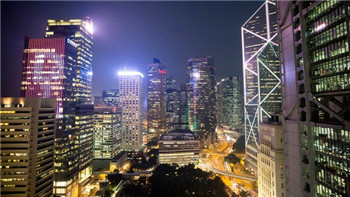(单词翻译:单击)

It is sometimes said that Bank of China’s Hong Kong skyscraper was designed to allow its bosses physically to look down on HSBC’s headquarters.
有时人们说,香港中银大厦的设计是为了让中国银行(BoC)的老板们可以俯视汇丰(HSBC)香港总部。
Officially, BoC’s IM Pei-designed masterpiece is meant to evoke the bamboo with its symbolic strength. Finished four years after HSBC’s Norman Foster edifice, there is, however, no doubt that BoC towers over its rival, at least in Hong Kong.
官方说法是,出自贝聿铭(IM Pei)之手的香港中银大厦在设计上仿照竹树不断向上生长,象征着力量和生机。其建成时间要比诺曼輠斯特(Norman Foster)设计的汇丰香港总部大厦晚四年,然而,毫无疑问,中银高出了竞争对手一头(至少在香港)。
Yet beyond the mainland, BoC has always been dwarfed by the commercial reach of its biggest rivals in Asia, including HSBC. Recent moves suggest it wants to change that — and this could be an auspicious time for one of the Chinese banks to aim for the international heft they so far lack.
然而,在中国境外,中行在商业触角范围上一直比不上最大的一些亚洲竞争对手,包括汇丰。中行最近的行动表明,它想改变这一局面,而现在可能正是中资银行寻求迄今仍不足的国际影响力的大好时机。
Last week Bank of China Hong Kong put itsNanyang commercial subsidiary up for sale for $8.7bn. The proceeds will be used to absorb Southeast Asian assets from its mainland parent. As a result, BoC’s international presence will be contained in one outwardly-focused unit just as China gears up for a massive overseas infrastructure lending boom. Put the two together,and BoC, through its Hong Kong operations, has thepotential to put down the roots of a genuine overseaspresence.
上周,中银香港(Bank of China Hong Kong)将旗下的南洋商业银行(NCB)挂牌出售,售价87亿美元。所得资金将被用于吸收其内地母公司在东南亚地区的资产。因此,伴随中国准备发起大规模的海外基建贷款热潮,中行的国际业务将被纳入一个向外聚焦的部门。两者相结合,中行通过其香港分支,将具有让其真正的海外扩张生根发芽的潜力。
A pan-Asian banking business is the dream of many lenders as private credit in the region looks likely to outstrip that of the US in the next decade. But the most striking point about the current reality is that most local giants are largely confined to their home markets — and the competition mainly comes from HSBC, Citigroup and Standard Chartered.
建立遍及全亚洲的银行业务是许多贷款机构的梦想,该地区的私营部门信贷规模有望在未来10年超过美国。但当前格局最引人注目的一点是,多数当地大型银行在很大程度上局限于本国市场,而竞争主要来自汇丰、花旗集团(Citigroup)和渣打银行(Standard Chartered)。
If wishing, or balance sheet size, made it so, then this would not be the case. Half of the world’s top 10 banks by assets are Asian, including BoC, China’s other Big Four banks and Japan’s Mitsubishi UFJ Group(MUFG). HSBC, JPMorgan, BNP Paribas, Barclays and Bank of America round out the list.
这种局面应该不是愿望(或者资产负债表规模)的产物。世界资产规模最大的10家银行有一半在亚洲,包括中国银行、中国四大银行中的其余三家以及日本三菱UFJ金融集团(MUFG)。榜单的另一半包括汇丰、摩根大通(JPMorgan)、法国巴黎银行(BNP Paribas)、巴克莱(Barclays)和美国银行(Bank of America)。
The main stumbling blocks for banks with pan-Asian ambitions, both local and western, have been a lack of genuine local presence in both financial and physical terms. Without local deposits to fund lending, banks take on currency risk in a region that knows all too well what pain the markets can inflict. The strength of HSBC, Citi and StanChart is based on their decades-old presence in many countries — something that is increasingly hard to replicate.
对于拥有泛亚洲雄心的银行(包括当地的和西方的)来说,主要障碍在于它们在金融和机构两方面都缺乏真正的当地地盘。没有当地存款为贷款提供资金,银行要承担汇率风险,而这一地区深知汇市可以造成怎样的痛苦。汇丰、花旗和渣打的实力建立在它们在许多国家数十年打造的地盘基础上,而这种模式越来越难以复制。


